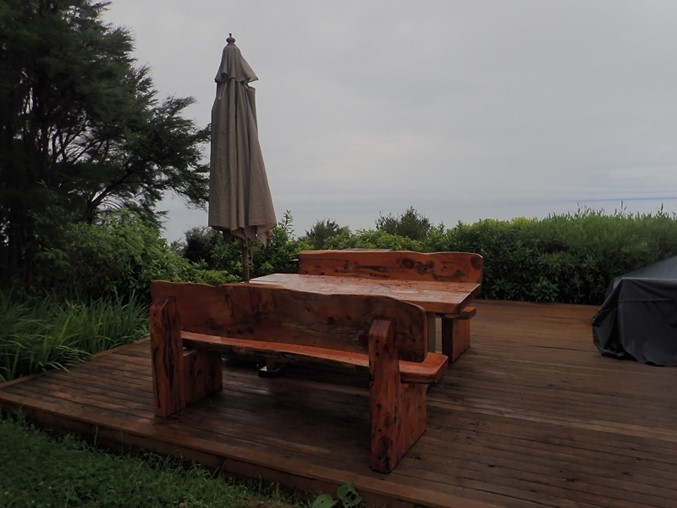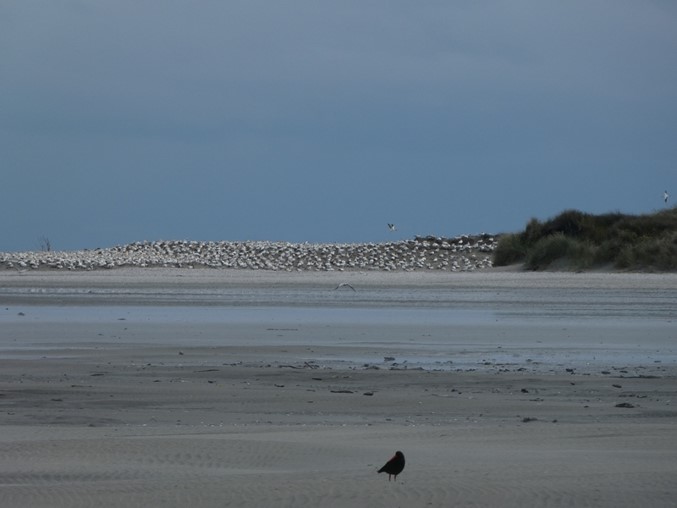Nelson, Golden Bay and Able Tasman National Park : 40:58.755S, 173:03.235E

Nelson is an attractive small city with a relatively modern cathedral and a lively atmosphere compared to the northern towns we are used to. We enjoyed a couple of meals out, including to celebrate our 35th anniversary and were able to catch up with Neil and Jane – hashing friends from the UK who live just outside the city. Rebell arrived three days after us having had a slower passage down the Tasman Sea, but with less motoring.
The cathedral is sited on a hill at the end of the High Street in lovely grounds. We visited during the Christmas Tree festival!
There are lots of outdoor cafes, including this trailer parked besides the marina. A great spot in the sunshine We decided to make use of our hire car while we had it and to have a road trip to Golden Bay, which is about 125 miles north west of Nelson, and booked two nights accommodation just outside Collingwood at Ao Marama Retreat. When we drove through this area in 2017 the road to Golden Bay over Takaka Hill was closed due to landslides following extra-tropical cyclone Gita. Nearly 4 years on and the road is still being repaired!
Looking back to Nelson from the top of Takaka Hill We stopped for lunch in Takaka, a place with a slightly hippy feel but with a nice wholefood café, then enjoyed an hour’s bush walk alongside a river to Wairua Falls before booking in to our accommodation.
A well made path alongside the river to Wairua Falls
Golden Bay was named for the gold that was found in the Aorere Vally in the 1850s, sparking a gold rush, rather than for the amazing sandy beaches Ao Marama, which is situated on a hill between the road and the beach, used to be a Buddhist retreat and maintains the simple ethos. There are 6 sleeping cabins, 4 of which share shower and toilet facilities, with an open air kitchen/barbeque/eating area. They have mains electricity, but the water is rainwater and you are encouraged to use the composting toilet rather than the flushing ones to save on water. The views from the site out into Golden Bay would be stunning, but we had chosen a dull few days to visit so didn’t really get to enjoy them.
Our sleeping cabin
Sun deck with barbeque and view! There was a short but steep walk down to the beach where there were a few baches (holiday homes), lots of driftwood and a flock of pied oystercatchers.
The oystercatchers take flight as we approach. We had booked a tour to Farewell Spit for the next day, but received a call in the morning to say it might be cancelled due to the weather – one forecast model showed rain all day. Luckily they made the call to go ahead as it stayed dry if still overcast. This was the first time we had needed to use our COVID passports which are now required in bars, restaurants and on tourist trips over here. The tour was amazingly informative about the history, ecology and wildlife of the area which is a magnet for migratory wading birds with the 32 km long Farewell Spit being designated as a wetland site of international importance under the Ramsar Convention.
The first stop on our tour was Cape Farewell, the most northerly point on the South Island and named by Captain Cook as it was his departure point at the end of his first visit to New Zealand
Then we were driven onto Farewell Spit in the tour company’s bus, specially adapted to cope with the sand dunes. This is the only company allowed to take tourists the full length of the spit and they are also involved in conservation work
As we drove down the spit we saw an number of New Zealand fur seals, which live here
The Bartailed Godwits had recently arrived after their amazing migration from Alaska – they make the 12,000km flight non-stop in about 9 days!
The Gannet Colony at the end of the spit is only just above sea level and the lower nests get swamped at certain tides – why do they nest there when there is higher land not far away?
A small number of Variable Oystercatchers also nest on the outside of the spit and rarely manage to raise chicks because the nests are covered by windblown sand or flooded. This year one pair have been successful and we were lucky enough to see one of the parents feeding its chick.
The Farewell Spit lighthouse is almost at the end of the spit and we saw it as we sailed into Tasman Bay on our approach to Nelson The Aorere Valley inshore from Collingwood is now an agricultural area and we drove up to Bainham to see the Langford Store. There is a Post Office, café and store serving a community of about 350, but you wouldn’t have know there were that many people around. The store is well stocked with second-hand fine china tea plates, cups and saucers, all carefully matched, but its not clear who the customers are!
The main street at Collingwood, with the hills behind shrouded in cloud as they were throughout our stay
The Langford Store. We were the only customers.
On our way back to Nelson we stopped for the short walk round Waikoropupu Springs, some of the most pure water in New Zealand after filtering down through the Karst of Takaka Hill. Back in Nelson we had an enjoyable evening at Neil and Jane’s house for Christmas drinks then when, on Wednesday, the sun came out for the first time since we arrived we left the marina to sail north to our current anchorage behind Adele Island in the Able Tasman National Park. We are sharing the bay with a number of yachts, including Desiderata who we first met in the San Blas Islands and Panama in 2017.
Sent from my iPad |


















 Sailing away from Nelson on the first sunny day since our arrival
Sailing away from Nelson on the first sunny day since our arrival